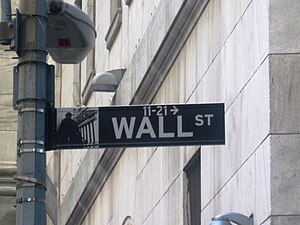| English: Wall Street sign on Wall Street (Photo credit: Wikipedia) |
Chicago, Jul.8, stock investing .- Nobody ever believes me when I tell them this is probably the best way to find great stocks.
My trick is to use Wall Street's army of thousands of analysts.
They've led to relative easy gains as high as 810% in the past few years. Honestly.
And best of all, they're continuing to do it even as the markets are showing the greatest signs of weakness in years.
It's not the way you're probably thinking, though. Here's how to do it.
Wall Street's Best-Kept Secret Exposed
You see, most Wall Street analysts are truly awful at their jobs.
And I mean awful.
The research found that between 2008 and 2012 investors could have made a fortune by doing one simple thing -- the exact opposite of what Wall Street says.
Let me explain...
Had you bought the 10 stocks Wall Street rated the highest at the beginning of each year, you would have lost an average 11% per year.
But you could have almost doubled the market by buying the most disliked stocks on Wall Street (the ones the analysts assign "sell" ratings to). If you bought what Wall Street told you to "sell," you would have made an average of 16% each year.
Those are just the averages though. If you're an active investor who uses Wall Street's "sell" recommendations as a starting point, you can truly make a fortune.
Difference Between A 52% Loss And A 810% Gain
One of my favorite examples of how bad Wall Street analysts' ratings are comes from one of the most successful companies of the last five years.
I'm talking about Netflix (Nasdaq: NFLX).
Not everyone always saw the Netflix story playing out as well as it has.
Wall Street sure didn't see it either. In fact, they probably couldn't have played it worse if they tried.
Look at Oppenheimer & Co., a 120-year-old money management and research firm on Wall Street with more than $160 billion under management, to see how not to play a major growth story.
Oppenheimer's research department initiated coverage on Netflix with a "buy" rating in May 2009. The stock was $40 at the time.
Two months later Oppenheimer downgraded Netflix from a "buy" to "sell" when it was $42.
They gave investors a solid two-month 5% gain. Not bad. But what they missed out on was truly great.
Since Oppenheimer said "sell," Netflix shares went on to climb from $42 to $175 in the next 15 months.
But the surging run in Netflix wasn't something Oppenheimer was willing to miss out on. Oppenheimer reversed its position and said "buy" after Netflix shares quadrupled.
Netflix shares continued to rise for a while. But then they turned down fast. Netflix shares fell, fell some more, and then fell some more. They ended up falling below $70. Oppenheimer kept the "buy" rating on them the whole time.
After watching shares fall more than 50%, Oppenheimer decided to cut its losses. It recommended "sell" on Netflix around $80 per share.
Since then Netflix shares have more than doubled again, recently trading for $210 each. That's more than doubling again after the latest "sell."
Here's a chart showing all the action:
 |
It's tough to imagine worse timing, right? But what's really worse are the costs.
An investor who just bought and held Netflix would have made more than 400%.
An investor who followed Oppenheimer's recommendations on Netflix would have lost 52% over this period.
Anyone who would have done the opposite of what Oppenheimer said would have made 810%.
Netflix isn't the only example, though. There are hundreds more.
Apple (Nasdaq: AAPL) is one of the most widely held stocks in the world. It's also covered by more than 50 analysts -- almost none of whom can get it close to right.
Between September 2008 and April 2009 when Apple was trading between $80 and $110 per share, analysts downgraded Apple shares six times.
After that, when Apple was hitting $700-plus highs, only one of the more than 50 analysts put a "sell" rating on the stock.
Unsurprisingly, Apple shares have fallen more than 40% since 49 of the 50 analysts covering the stock refused to say "sell."
Buy Cheap, Get Rich
Over the last three decades in the investment research business, I've learned one thing: The simplest way to get rich in stocks is to buy cheap stocks that are out of favor.
Wall Street hates cheap stocks. When a stock is up, they say "buy." When it's down, they say "sell."
If you're looking to traverse a turbulent market safely and profitably, Wall Street's analysts can be a great help.
History has proven you can make a fortune simply by picking up Wall Street's trash.
This trick and a few others have helped me deliver massive gains over the last 31 years in every type of market you can imagine. Learn more tricks of being a Cheap Investor here..


No comments:
Post a Comment